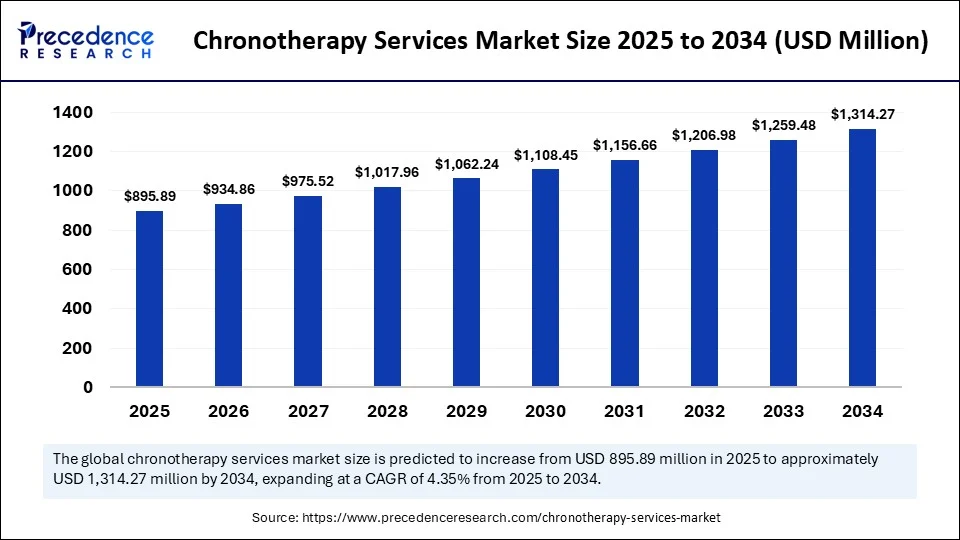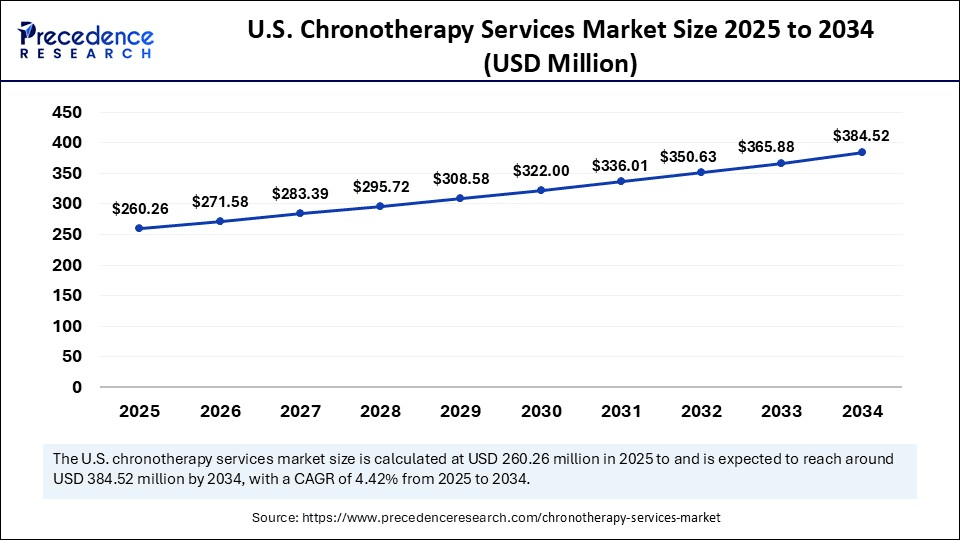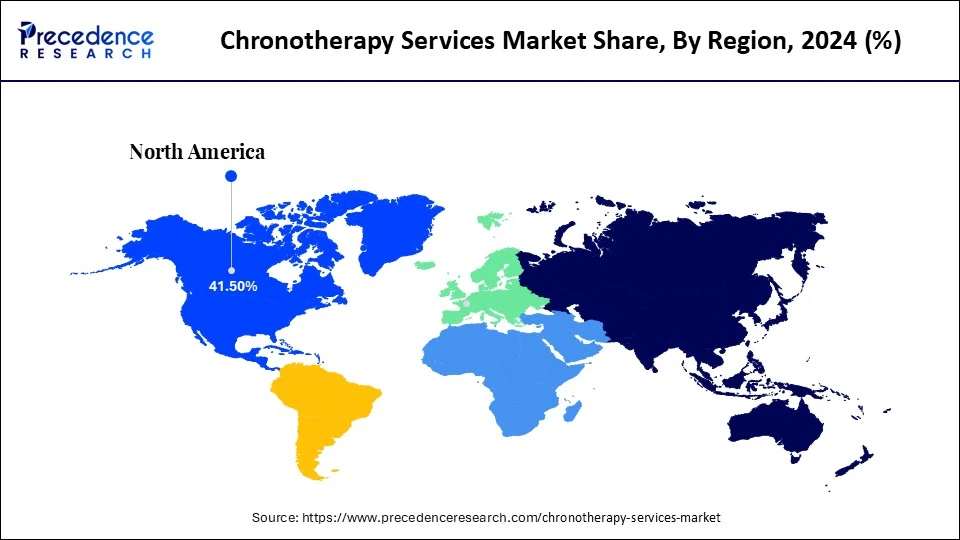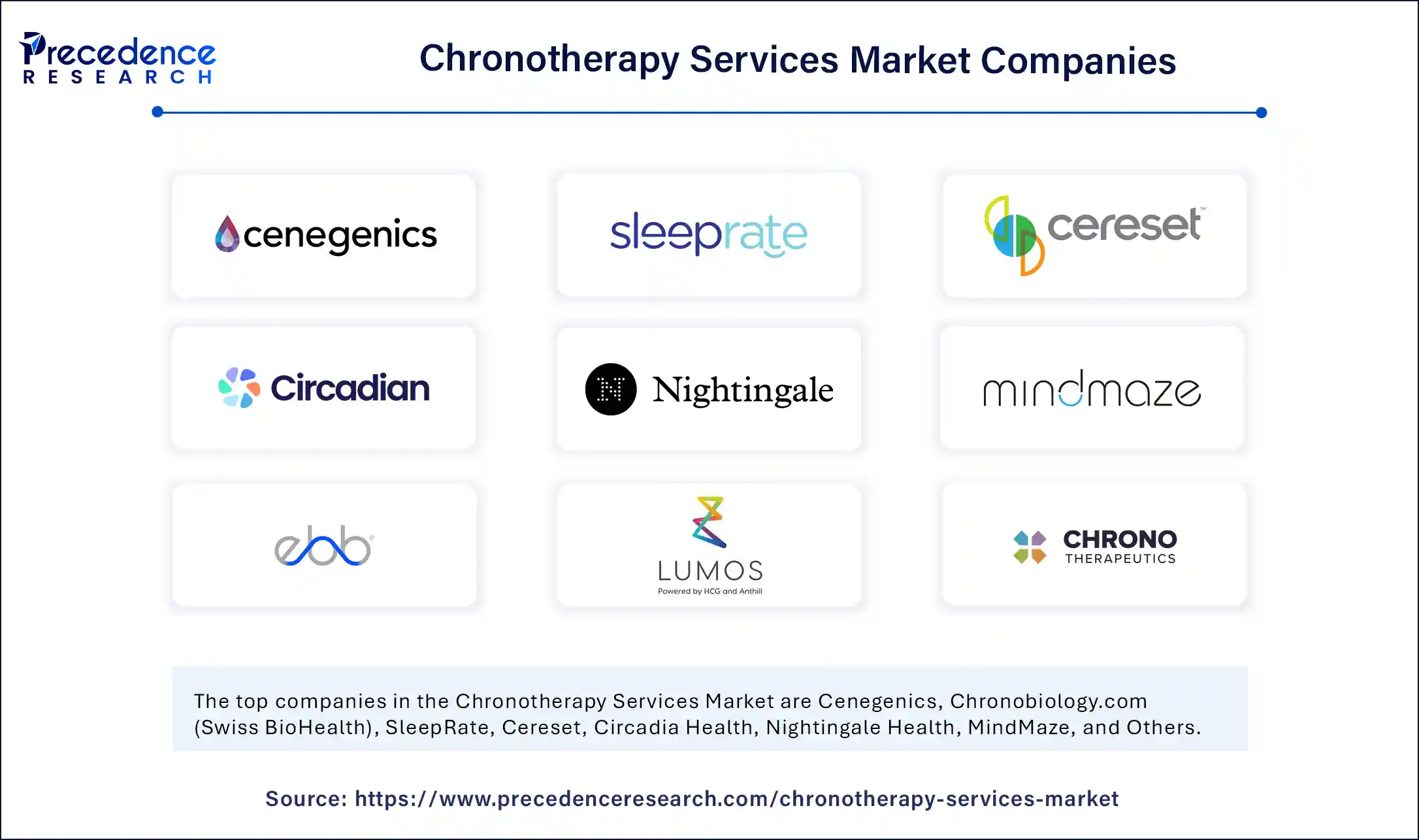List of Contents
Chronotherapy Services Market Size and Forecast 2025 to 2034
The global chronotherapy services market size accounted for USD 858.54 million in 2024 and is predicted to increase from USD 895.89 million in 2025 to approximately USD 1,314.27 million by 2034, expanding at a CAGR of 4.35% from 2025 to 2034. The chronotherapy services market is driven by rising demand for personalized medicine, increasing awareness of circadian rhythms, and advancements in diagnostic technologies.

Chronotherapy Services MarketKey Takeaways
- In terms of revenue, the global chronotherapy services market was valued at USD 858.54 million in 2024.
- It is projected to reach USD 1,314.27 million by 2034.
- The market is expected to grow at a CAGR of 4.35% from 2025 to 2034.
- North America dominated the chronotherapy services market with the largest market share of 41.50% in 2024.
- By region, Asia Pacific is anticipated to witness the fastest growth during the forecasted years.
- By therapy area, the sleep disorders segment captured the biggest share of 33.50% in 2024.
- By therapy area, the psychiatric conditions segment is expected to grow at the fastest CAGR over the forecast period.
- By service type, the chronotherapy scheduling segment contributed the highest market share of 32.50% in 2024.
- By service type, the diagnostic services segment is anticipated to show considerable growth over the forecast period.
- By delivery mode, the clinic-based services segment held the major market share of 46.50% in 2024.
- By delivery mode, the home-based services segment is expected to grow at a significant CAGR over the forecast period.
- By patient type, the adults (18–65 years) segment generated the largest market share of 51.50% in 2024.
- By patient type, the pediatrics and adolescents segment is expected to grow at the fastest CAGR during the forecast period.
- By end-user, the sleep clinics and chronobiology centers segment accounted for significant share of 37.50% in 2024.
- By end-user, the home healthcare providers segment is anticipated to show considerable growth in the market over the forecast period.
How is AI Integration Transforming the Chronotherapy Services Market?
Artificial intelligence integration advances the chronotherapy market through more precise, personalized interventions. Machine learning and predictive analytics analyze complex data, like sleep patterns, hormone levels, stress, and vital signs, to offer tailored solutions. Chronotherapy is undergoing an AI revolution in clinical workflows and drug development. In pharmaceutical research, AI is useful for identifying time-variant drug targets and optimizing chronopharmacokinetic models, improving the design of circadian-adapted therapy. The growing demand for precision medicine is increasing as AI enables the use of chronobiological data and the automation of personalized care, hence being one of the strongest catalysts of the market's fast growth.
U.S. Chronotherapy Services Market Size and Growth 2025 to 2034
The U.S. chronotherapy services market size was exhibited at USD 249.41 million in 2024 and is projected to be worth around USD 384.52 million by 2034, growing at a CAGR of 4.42% from 2025 to 2034.

Why is North America Leading the Global Chronotherapy Services Market?
North America dominated the global market with the highest market share of 41.50% in 2024 and is expected to sustain its dominance during the forecast period. This is mainly due to the region's well-developed healthcare infrastructure, significant healthcare spending, and emphasis on personalized medicine. Favorable regulatory practices and government support for innovative therapies also accelerate chronotherapy research. Furthermore, increased awareness among healthcare providers and patients regarding the benefits of aligning treatment with circadian rhythms is boosting the popularity of chronotherapy services.
The U.S. is a major player in the chronotherapy services market within North America. This is due to the increase in clinical research concerning the impact of circadian timing on disease management. There is a high adoption of chronotherapy across hospitals and specialty care centers to manage chronic diseases, including cancer, asthma, cardiovascular diseases, and mental health disorders, contributing to market growth.

Why is the Asia Pacific Witnessing the Fastest Growth?
Asia Pacific is expected to grow at the fastest CAGR during the forecast period. The growth of the market within the region is fueled by increased healthcare spending, growing awareness of circadian health, and the rise of digital health solutions. High rates of sleep and mood disorders in urban populations, linked to lifestyle stress and disrupted sleep patterns, also contribute to market growth. Government support, increased investment in medical research, and the development of digital platforms for patient monitoring and treatment scheduling are further driving the growth of the market.
China exhibits high growth potential. Chronotherapy is increasingly adopted in Chinese healthcare facilities for managing chronic diseases like diabetes, hypertension, and sleep disorders. Urban areas are leading this adoption, supported by advanced healthcare infrastructure and the use of digital health tools such as mobile health apps and wearables.
What are the Key Factors Driving the Growth of the European Chronotherapy Services Market?
The European chronotherapy services market is expected to grow at a notable rate during the projection period. Chronotherapy is gaining traction as an integrated treatment approach in European countries due to its potential to improve outcomes and reduce side effects. The aging population and the prevalence of chronic conditions in Europe are driving demand for personalized, time-sensitive treatments. Germany leads the European chronotherapy market, with significant research and clinical focus on the role of circadian rhythms in disease management. The country's strong digital health and medical research infrastructure is integrating circadian information into individualized care pathways.
Market Overview
The chronotherapy services market refers to the niche but rapidly evolving segment of the healthcare industry that involves the provision of therapeutic interventions and treatment schedules aligned with the body's biological rhythms or circadian cycles. Chronotherapy is used to optimize the efficacy and safety of medical interventions by timing medication administration, behavioral therapy, or light exposure according to the patient's internal clock. The services may involve diagnostics, personalized treatment scheduling, remote monitoring, and delivery of therapeutics tailored to circadian timing, especially in fields such as oncology, psychiatry, sleep medicine, cardiovascular disorders, and metabolic diseases.
The chronotherapy services market is expanding because of the rising popularity of circadian biology in managing and treating diseases. Increased research in chronobiology, which optimizes drug use and reduces side effects, fuels this demand. The rise in chronic conditions like cancer, heart disease, and hypertension, where treatment timing is critical, also drives the demand for chronotherapy. Supportive healthcare policies and increased investment in precision medicine further boost market growth.
What Factors are Fueling the Rapid Expansion of the Chronotherapy Services Market?
- Progress in Chronobiology Studies: Current efforts in the chronobiology community are discovering the complex interactions between the disease processes and the circadian program. Such results will allow the implementation of more specific and time-sensitive treatment plans, considerably advancing the treatment outcomes.
- Rising Demand in Personalized Medicine: Personalized medicine in the healthcare business is increasing the demand for chronotherapy since it offers medication in consideration of the biological clock of every individual. The medicines in sync with the circadian rhythm of a patient make them more effective and restrict their side effects.
- Surveillance of Technology Developments: Newer technologies, such as wearable, biosensors, and digital health technologies, provide more promise to measure circadian rhythms in real-time. Technology may facilitate feasible chronotherapy because of its greater availability and inclusion in the healthcare system, which also contributes to an increase in adoption and market spread.
Market Scope
| Report Coverage | Details |
| Market Size by 2034 | USD 1,314.27 Million |
| Market Size in 2025 | USD 895.89 Million |
| Market Size in 2024 | USD 858.54 Million |
| Market Growth Rate from 2025 to 2034 | CAGR of 4.35% |
| Dominating Region | North America |
| Fastest Growing Region | Asia Pacific |
| Base Year | 2024 |
| Forecast Period | 2025 to 2034 |
| Segments Covered | Therapy Area, Service Type, Delivery Mode, Patient Type, End Use and Region |
| Regions Covered | North America, Europe, Asia-Pacific, Latin America, and Middle East & Africa |
Market Dynamics
Drivers
Enhancing Clinical Outcomes by Circadian-based Treatment
One of the major factors driving the growth of the chronotherapy services market is the ability of chronotherapy to greatly improve treatment outcomes by synchronizing interventions with natural body cycles. Synchronizing treatments with the body's natural cycles can significantly enhance the effectiveness of therapies. This is because the body's physiological functions, such as hormone secretion, body temperature, and immune responses, fluctuate throughout the day. These rhythms regulate hormone secretion, body temperature, and cardiovascular and immune responses. Chronotherapy administers medications at the most favorable time, thereby avoiding peak times of low effectiveness and increased adverse effects. This has a positive effect on treatment efficacy, increases patient acceptance, reduces side effects, improves quality of life, and increases treatment compliance.
Restraint
Compliance of the Patients to Gain Time-Dependent Treatment Regimes
One of the major factors restraining the growth of the chronotherapy services market is the difficulty in ensuring consistent patient compliance. This is because the treatment's effectiveness relies on strict time adherence. Chronotherapy is designed around the precise timing of medications, aligning with the body's natural rhythms to maximize efficacy and minimize side effects. However, maintaining these strict schedules can be difficult for many patients due to their varied daily activities, work commitments, social engagements, and sleep disruptions. Missed or improperly timed doses can disrupt the therapeutic process, reducing the effectiveness of chronotherapy and potentially creating risks due to fluctuating drug levels in the body. Moreover, implementing chronotherapy can be complex and expensive, requiring specialized knowledge, equipment, and monitoring.
Opportunity
Advanced Drug Delivery Systems Can Optimize the Precision of Chronotherapy
The rising development of advanced drug delivery systems, wearable sensors, and monitoring technologies is opening up new possibilities in this market. Since chronotherapy relies on synchronizing drug delivery with the body's natural rhythms, maintaining a consistent drug level is key to optimizing treatment effects. Controlled-release formulations, like extended-release tablets, transdermal patches, and injectable depots, play a crucial role here. These technologies aim to stabilize drug levels in the bloodstream over time, maximizing therapeutic effects while minimizing side effects. This presents a significant market opportunity for pharmaceutical innovation.
Therapy Area Insights
Why is the Sleep Disorders Segment Leading the Chronotherapy Services Market?
The sleep disorders segment dominated the market, accounting for a 33.50% share in 2024. This is mainly due to the increased prevalence of conditions like insomnia, sleep apnea, and circadian rhythm sleep-wake disorders, driving the need for chronotherapy. Chronotherapy has proven to be highly effective in treating these conditions by aligning treatments with the body's natural sleep-wake cycles. Furthermore, growing awareness of the importance of sleep health, increased stress levels, and longer working hours have contributed to a higher demand for chronotherapy services for sleep-related issues. This market segment is also benefiting from the introduction of technological solutions, such as wearable sleep-tracking devices and software that can tailor therapies to individual sleep patterns.
The psychiatric conditions segment is expected to grow at a significant CAGR over the forecast period. This is mainly due to the increasing use of circadian-based behavioral therapy for mental health conditions like depression, bipolar disorder, seasonal affective disorder (SAD), and anxiety, all of which are linked to circadian rhythm disruptions. Growing awareness of mental health issues and the global rise in psychiatric diseases have increased the demand for innovative treatments. Advances in chronobiology and digital health technologies are also enabling clinicians to precisely tailor treatment timing.
Service Type Insights
Why Did the Chronotherapy Services Market in 2024?
The chronotherapy scheduling segment dominated the market with a 32.50% revenue share in 2024. This is mainly due to the increased focus on adjusting the timing of medication administration to match an individual's circadian rhythm, thereby maximizing therapeutic benefits and minimizing adverse effects. The growing understanding of the time-dependent nature of biological processes is driving the need for scheduled treatments in cardiovascular, cancer, and neurological therapies. Personalized treatments are a crucial aspect of effective healthcare, particularly with the rise of chronic diseases and the advancements in precision medicine. Furthermore, digital health technologies and smart scheduling tools are facilitating the implementation and adherence to personalized medication schedules, thus contributing to the growth of this segment.
The diagnostic services segment is expected to grow at the fastest rate in the upcoming period due to the increasing demand for personalized and precision healthcare. Diagnostics include wearable devices, sleep monitoring solutions, hormone level assessments, and body temperature monitoring to identify circadian phase indicators. This segment holds significant growth potential due to the rising healthcare need for precise, patient-specific diagnostics within chronotherapy services.
Delivery Mode Insights
What Made Clinic-Based Services the Dominant Segment in the Market in 2024?
The clinic-based services segment has captured a revenue share of 46.50% in 2024. Chronotherapy is primarily implemented in hospitals and clinics, which offer time-based management strategies for various chronic and acute conditions, including hypertension, cancer, and psychiatric disorders. These healthcare facilities utilize advanced diagnostic tools like circadian rhythm machines and biomarker testing to tailor care to each patient's biological clock. The increasing support for personalized medicine, along with technological advancements in circadian diagnostics and treatment timing, further fuels the growth of chronotherapy services provided by these clinical settings.
The home-based services segment is expected to grow at a significant CAGR over the forecast period, driven by the growing adoption of digital therapeutics and wearable technologies. Wearable devices, mobile health apps, and remote monitoring systems track sleep patterns, activity levels, and other relevant metrics. This approach offers convenience and flexibility, leading to improved patient adherence, reduced strain on healthcare facilities, and lower treatment costs. Furthermore, telemedicine enables healthcare professionals to provide continuous support in adjusting treatment schedules remotely, thereby enhancing the efficiency of home-based care.
Patient Type Insights
Why Does the Adults Segment Hold the Largest Share of the Chronotherapy Services Market in 2024?
The adults segment dominated the market, capturing a 51.50% revenue share in 2024. The prevalence of chronic diseases, such as cardiovascular diseases, cancer, metabolic conditions, sleep disorders, and mental health issues in adults, has increased. The responses to treatments for these conditions are often linked to circadian rhythms. The rise of personalized medicine and the popularity of wearable health trackers and health apps have empowered adult patients to take greater control of their treatment plans. As the adult population grows and ages, the demand for personalized, time-sensitive therapeutic interventions is expected to remain high, with lifestyle factors also contributing to circadian disruption.
The pediatrics & adolescents segment is expected to grow at the fastest rate in the upcoming period. Inconsistent circadian timing has been linked to neurodevelopmental issues in children and adolescents, including ADHD, autism spectrum disorders, and sleep disturbances. Circadian-based strategies are increasingly incorporated into treatment plans by pediatricians and child psychiatrists, aiming to improve therapeutic outcomes while reducing reliance on medications. The development of pediatric-friendly wearable devices and sleep monitoring solutions is simplifying the monitoring of circadian health in younger populations for both caregivers and clinicians.
End-User Insights
What Made Sleep Clinics & Chronobiology Centers the Dominant Segment in the Market in 2024?
The sleep clinics and chronobiology centers segment dominated the chronotherapy services market, capturing a 37.50% revenue share in 2024. Specialized centers play a crucial role in diagnosing and treating circadian rhythm disorders, such as insomnia and delayed sleep phase disorders. The rise of chronobiology and sleep clinics has led to innovative diagnostics and personalized treatment approaches. These clinics utilize sleep tracking systems, hormone level measurements, and personal circadian rhythm mapping to optimize treatment effectiveness.
The home healthcare providers segment is expected to grow at the fastest CAGR in the near future, driven by the increasing focus on chronic disease management and patient-centered care. Digital therapeutics, remote monitoring, and wearable devices are making home-based chronotherapy more accessible by supporting time-specific treatments. Home healthcare offers greater convenience, reduces hospital visits, and enhances treatment adherence. This trend is further fueled by the growing awareness of chronotherapy benefits and advancements in technology that facilitate its administration at home.
Recent Developments
- In May 2023, Genmab A/S obtained USFDA approval of EPKINLY (epcoritamab-bysp), a T-cell-engaging bispecific antibody directed towards adult patients with relapsed or refractory (R/R) diffuse large B-cell lymphoma (DLBCL). Such treatment will give a new alternative to people who are affected by this violent type of lymphoma.
(Source: https://ir.genmab.com)
- In April 2023, Genentech, a member of the Roche Group, obtained USFDA approval to use Polivy (polatuzumab vedotin-piiq), its cancer therapy drug, in combination to use with Rituxan (rituximab), cyclophosphamide, doxorubicin, and prednisone (R-CHP). This combination is to treat patients with previously untreated diffuse large B-cell lymphoma (DLBCL) who are adults.
(Source:https://www.fda.gov)
Chronotherapy Services Market Companies

- Cenegenics
- Chronobiology.com (Swiss BioHealth)
- SleepRate
- Cereset
- Circadia Health
- Nightingale Health
- MindMaze
- Ebb Therapeutics
- The Circadian Sleep Disorders Network
- LumosTech (Lumos Health)
- Chrono Therapeutics
- Pear Therapeutics
- Headspace Health
- ResMed
- Somnology Inc.
- BetterSleep (by Ipnos)
- Emfit Ltd.
- SleepScore Labs
- Nox Health
- Bright Therapeutics
Segments Covered in the Report
By Therapy Area
- Sleep Disorders
- Psychiatric Conditions (e.g., depression, bipolar disorder)
- Oncology (e.g., circadian-timed chemotherapy)
- Hypertension and Cardiovascular Disorders
- Metabolic and Endocrine Disorders (e.g., diabetes, obesity)
- Neurological Conditions (e.g., Alzheimer's, Parkinson's)
- Chronopharmacology in Pain Management
By Service Type
- Chronotherapy Scheduling & Optimization Services
- Diagnostic Services (Actigraphy, Salivary Cortisol, Melatonin Profiles)
- Behavioral & Cognitive Chronotherapy Programs
- Light Therapy and Circadian Realignment Programs
- Remote Monitoring & Wearable-Based Services
- Pharmacological Timing Consultations
By Delivery Mode
- Clinic-Based Services
- Home-Based Services
- Telehealth/Virtual Chronotherapy Consultations
- Hospital-Based Services (within oncology or psychiatry departments)
By Patient Type
- Adults (18–65 years)
- Pediatrics and Adolescents
- Geriatric Patients
By End Use
- Sleep Clinics & Chronobiology Specialty Centers
- Hospitals & Academic Medical Centers
- Behavioral Health Clinics
- Home Healthcare Providers
- Corporate Wellness & Occupational Health Programs
By Region
- North America
- Europe
- Asia-Pacific
- Latin America
- Middle East & Africa
For inquiries regarding discounts, bulk purchases, or customization requests, please contact us at sales@precedenceresearch.com
Frequently Asked Questions
Ask For Sample
No cookie-cutter, only authentic analysis – take the 1st step to become a Precedence Research client